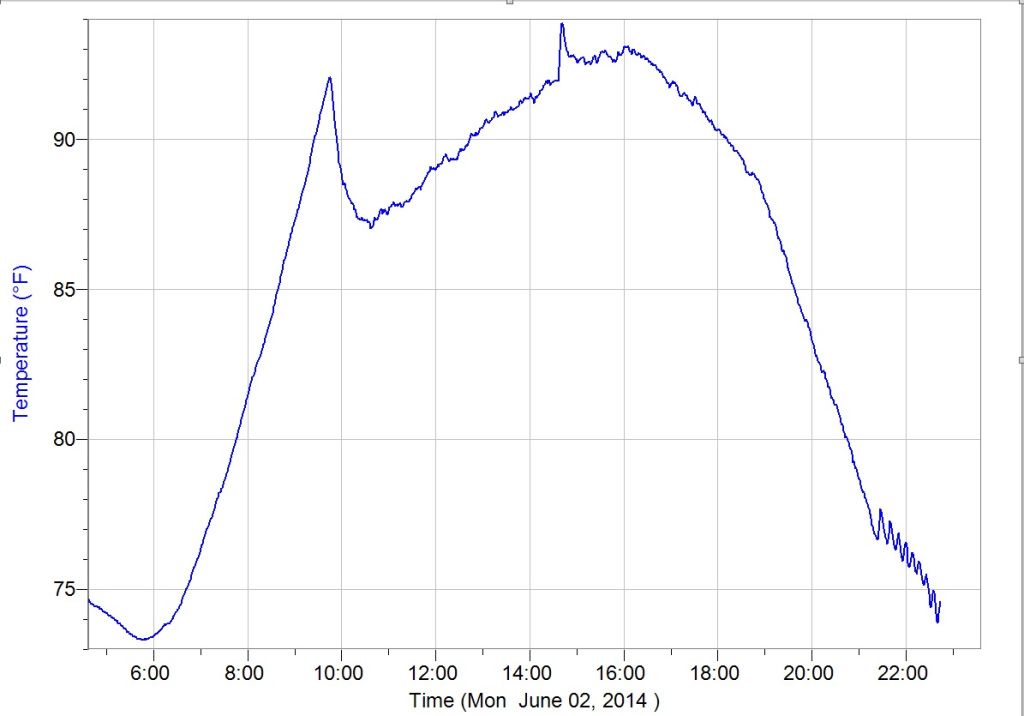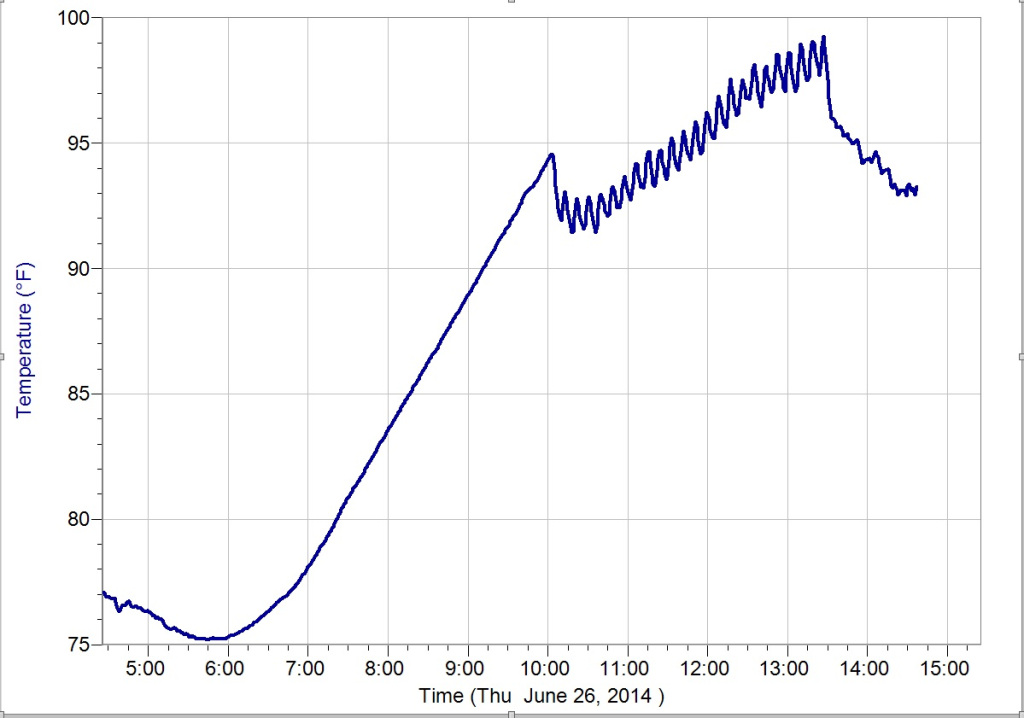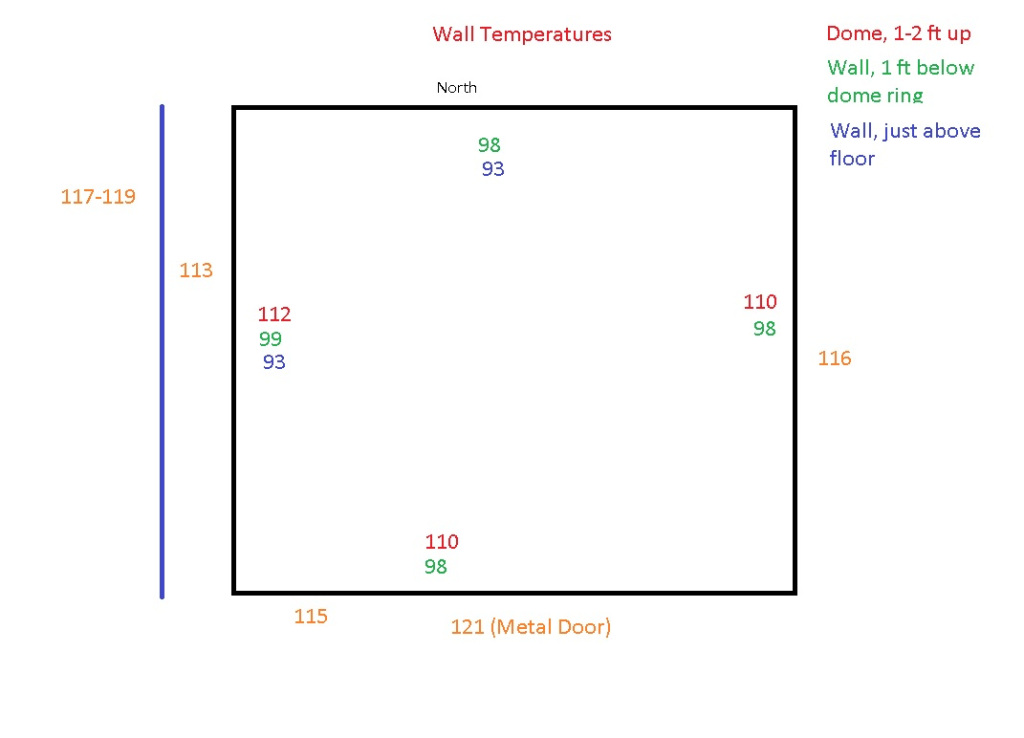I am starting to get more concerned about the temperature in the Dome during the day. It gets crazy HOT here in AZ.
Step 1 – installed a tarp over the western wall where the sun is hottest. The tarp attaches to the top of the wall (a few inches above the top edge, leaving room for the dome lower shutter to go over), then slants out a couple of feet to the ground. Attached the bottom to the ground with stakes, with big bricks on top to keep the wind from pulling up the stakes. The tarp appears to drop the wall temperature 5-6 degrees, and blocks the UV.
Step 2 – I decided to insulate and drywall the observatory. I should have done this in the very beginning, of course, but didn’t realize just how hot it was going to be. I had expected the window air conditioner to be able to handle the heat:(
Removed all the equipment except the telescopes. Put giant plastic garbage bags ove the telescopes and the mount. Pulled the pegboard off the walls, installed insulation both above and below the floor. Did this part at night so it was somewhat cooler – only 90 degrees:) Then put drywall on the walls, both above and below floor.
I installed a Vernier sensor device (LabPro) and the associated software on the observatory computer so I could monitor the temperature. I am measuring the temperature on top of the electronics cabinet, about a foot below the mount. There is clearly a strong temperature gradient from the floor to the dome. The window air conditioner is situated just above the floor, so the cooling mostly wants to sit on the floor and sink below it. I have a small fan below the air conditioner to help blow the cool air up into the room. This helps a bit.
Here is a temperature graph from before the insulation project:
You can see the overnight temperature of 73 rises quickly at sunrise. A little after 10AM the air conditioner was turned on, with the temperature about 92. The temperature drops to 87, about 5 degrees. It the continues to climb, although at a slower rate. The temperature peaked at 4 PM; the AC was turned off about 10:30 PM. Notice the squiggles aroun 9-10 PM; this is when the AC “cycles”, where it just blows for awhile, then actually cools awhile, then goes back to just running the fan. You might think this is oscillating around the AC setpoint, which is 72. However, the temperature does not seem to be close to that setpoint. I see this pattern show up every so often.
Her is today’s data, with the insulation installed.
At 10 AM the AC cut in and dropped the temperature a couple of degrees, after which the temperature continues to climb. The cycling of the AC is very evident.
At 1:30 PM, I went out and moved the computer cabinet and repositioned the small fan. I had cleverly positioned the cabinet so it “blocked” part of the AC vent, forcing cool air to flow through the cabinet (the cabinet has screen doors for air flow). I moved the cabinet so the AC vent was unobstructed. I also repositioned the small fan so it was blowing more upward from below the AC; it had gotten knocked to the side a bit.
These changes caused a) an immediate drop in temperature of about 7 degrees, and b) cessation of the cycling of the AC. I wonder if the cycling is removed by the small fan more efficiently moving the cool air away from whatever sensor the AC uses to measure the temperature.
Clearly the insulation project has not resulted in a room that can be controlled at a steady temperature by the AC. The dome is a major heat source which the AC cannot overcome.
Wall Temperatures
I took my little Infrared temperature measuring gun and checked the various wall temperatures, inside and out.
This was done about 1:30PM, so the East wall has started cooling from its high and the West wall has started heating in direct sun.
The interior wall gradient is pronounced, with temperatures going from 93 near the upper floor up to 112 on the interior dome surface.
The tarp is doing some good, lowering the temperature several degrees (and blocking UV). The metal door is absorbing a lot of heat.
The Celestron scope measured 101, while the Paramount measured 93.



